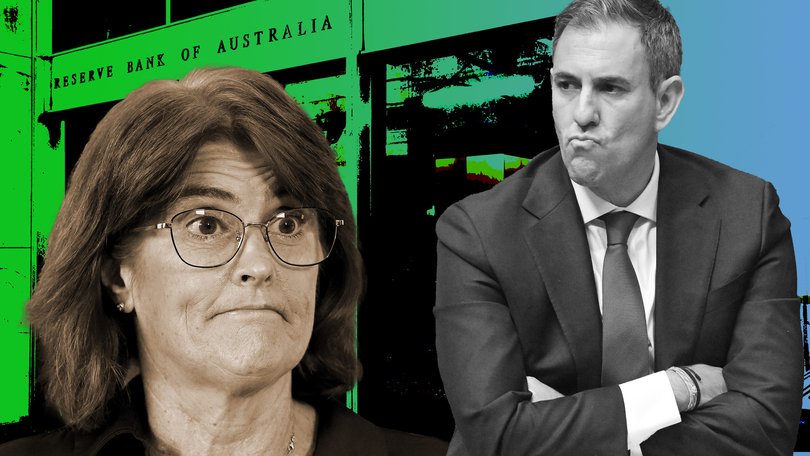RBA decision: Interest rate cuts tipped but consumers yet to spend

Rates will be one quarter of a percent lower on Tuesday afternoon if markets are any guide. Whether the economy will regain its animal spirits is another question.
According the Australian Securities Exchange Rate Tracker, there is a 97 per cent chance of a rate cut, a view supported by the economic fraternity.
RSM Australia economist Devika Shivadekar is one of them.
Sign up to The Nightly's newsletters.
Get the first look at the digital newspaper, curated daily stories and breaking headlines delivered to your inbox.
By continuing you agree to our Terms and Privacy Policy.“We’ve brought forward our expectation for the next RBA rate cut to July, and see little justification to wait until August to do what they can do this week,” she said.
Ms Shivadekar sees softer-than-expected GDP growth, subdued business conditions, tepid consumer sentiment, and benign May inflation as more than enough reasons to cut. In May, inflation figures showed inflationary pressures are fading more quickly than previously anticipated and likely to stay within the RBA’s 2–3 per cent target range.
With official interest rates still above the so-called “neutral rate” — neither expansionary or contractionary — the risk has moved from inflation to choking off demand.
“In the face of weak growth and fading price pressures, there’s a stronger case for the RBA to act sooner to support demand. Unlike its global peers who continue to prioritise inflation control, the RBA appears more concerned about the risks of overtightening, particularly as private sector demand struggles to pick up the slack from waning public stimulus,” Ms Shivadekar said.
The economy has moved from being buffeted by global headwinds, namely the supply shocks from COVID and war in Ukraine, sending prices for energy, goods and services skyrocketing to being effectively becalmed — limping along at 1.4 per cent GDP growth per year, with employment at record lows, and little in the way of animal spirits to kickstart growth and encourage consumers to take risks.
That is being felt not just in the jobs numbers, where job mobility is not far off record lows, but in bank accounts.
Conservatism when it comes to spending has been a hallmark of the current rate cutting cycle, with just one in ten mortgage holders opting to reduce their repayments after the May cut. A similar phenomenon occurred in February.
“Some of the challenge in the pickup in consumption to date is consumers really ran down their savings rates over recent years to maintain their level of spending despite that big pressure from inflation and higher rates,” said Gareth Spence, head of Australian economics at National Australia Bank.
“Even though real incomes and the labour market are quite healthy at the moment, they’re probably doing a bit of recovery after that shock of recent years.”
While mortgage holders are getting ahead on their payments, cashed up older Australians are seeing less disposable income. Lower rates means lower returns on cash balances, cutting into the amount available to spend.
With little momentum generated by consumers, businesses are also sitting on their hands.
“The two rate cuts this year have not been significant to materially alter operating conditions, though sentiment is showing signs of improvement,” Ms Shivadekar said.
“Without a meaningful lift in consumer demand, the overall environment for businesses remains largely unchanged.”
Despite the broader economic malaise, business credit growth has remained surprisingly resilient.
“Business credit is something that should be quite sensitive to interest rates,” Mr Spence said, “but it’s actually been quite strong — tracking at about nine and a half per cent over the year, well above pre-pandemic rates.”
He attributes the momentum to larger firms with stronger balance sheets and greater ability to manage cash flow, while smaller businesses appear more constrained. Investment remains uneven across sectors, with relative strength in construction and services, but ongoing weakness in goods production, manufacturing, retail and wholesale.
“Margins, labour costs and other input pressures continue to weigh on confidence,” he said. For animal spirits to return, Mr Spence says the key will be a visible rebound in consumer demand.
“That’s still the missing piece — domestically, we haven’t seen the pickup we were hoping for by mid-year.”
Labour market conditions remain a rare bright spot in an otherwise sluggish economy. Job ads, a forward-looking measure of hiring intent, rose 1.8 per cent in June after two consecutive monthly declines, according to the ANZ-Indeed Job Ads index, leaving them down just 0.4 per cent over the year.
“Australian job ads have been broadly stable over the past year, continuing to support employment growth and helping keep the unemployment rate low,” said Callam Pickering, APAC economist at Indeed.
“This is still a job market that is broadly favourable to the jobseeker, with plenty of opportunities available for those looking for higher pay or more responsibility.”
June’s gains were concentrated in New South Wales and Queensland, offsetting falls in Victoria and South Australia. Pickering said job ads for management, sales, and software development roles had rebounded, while education and nursing continued to weaken, a sign of a re-balancing of the economy toward the private sector.
While the tight labour market offers some reassurance, Mr Pickering said the global outlook remains uncertain and could weigh on hiring decisions.
“Employers will benefit from lower interest rates, but it will take some time for rate cuts to fully flow through an economy. Cuts made earlier this year will only truly be felt next year,” he said.
He added that further rate cuts may still be required to support demand.
“Domestic weakness, combined with a weaker global economic outlook, suggest that further rate cuts may be necessary. We believe the RBA will need to cut rates at least another couple of times this year to provide sufficient support to households and businesses, while ensuring that the unemployment rate remains low and we avoid recession.”
Whether the central bank moves again in August will depend on incoming data, particularly the full second-quarter CPI and labour market updates.
Ms Shivadekar said the shift in stance reflects the RBA’s growing confidence in the disinflation trend and rising concern about the risks of overtightening in a fragile economy.
“Unlike its global peers who remain cautious, the RBA is responding to local conditions — including slowing private sector momentum, reduced public stimulus, and concerns over China’s outlook,” she said.
RSM expects the cash rate to end the year at 3.35 per cent, implying two more cuts in 2025, though Ms Shivadekar said a third cut to 3.10 per cent remains possible if the economy can’t get out of second gear.

